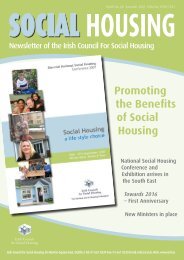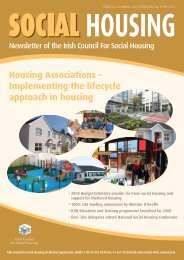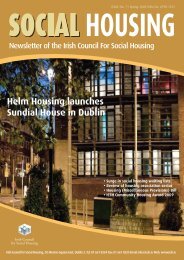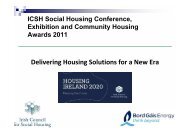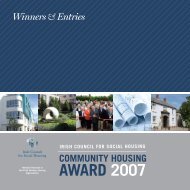8.32 In assessing and planning to meet this need, it is vital that there is close liaison, both<strong>with</strong>in, and between housing authorities and other statutory and voluntary agencies. Whereit is identified in the housing assessment process that an applicant has particular needs, thehousing authority should establish design requirements to address these needs, and plan <strong>for</strong>these in the design and construction / adaptation of housing. Any funding implications i.e.identified cost implications or issues which are likely to give rise to increased costs, shouldbe taken into consideration at the planning stage and sufficient resources allocated byhousing authorities. The proposed tenant should be involved at the stage of internal designand to ensure that fixtures and fittings are positioned to suit individual need. In the case ofchildren <strong>with</strong> specific design needs, such consultation should include ongoingcommunication <strong>with</strong> the child’s parents/family. For children <strong>with</strong> disabilities, it is importantthat their current and future needs are central to the process of allocating housing tofamilies. It is recognised that the development of once off housing design can create a timelapse between the identification of the need and the realisation and occupation of theaccommodation. To address this, it is essential that longer term planning mechanisms areutilised to identify future need, e.g. the strategic assessment of need protocol, which willaim to identify the current and future extent of local housing need of people <strong>with</strong>disabilities, will assist in this regard.8.33 As a mechanism to increase the stock of accessible social housing, considerationshould be given to the inclusion of a range of basic accessibility provisions, to make housingvisitable, as part of social housing improvement programmes which provide <strong>for</strong> theretrofitting of insulation and improvements in energy efficiency of vacant properties.Furthermore, where vacant social housing has been identified <strong>for</strong> improvements under theretrofitting programme, consideration could be given to the undertaking of a more extensivesuite of accessibility works, where it has been identified that the house, once improved,would be suitable to meet the needs of a disabled household on the local authority housingwaiting list. This should be managed through the allocations process. Furthermore, it isimportant that capital funding be prioritised <strong>for</strong> the undertaking of adaptation works <strong>for</strong> localauthority tenants who have disabilities.8.34 Work has been ongoing in the area of specific needs design, e.g. Dublin City Councilhas developed a generic wheelchair accessible unit design template giving a unit footprintsize while allowing <strong>for</strong> personal preference in the interior design and placement of fixturesand fittings which could be used as a template to facilitate the creation of a supply ofwheelchair accessible housing which can alleviate the time lapse. Furthermore, the IWA, inits good practice guidelines, Designing Accessible Environments, sets out their guidelines <strong>for</strong>lifetime adaptable housing design. These guidelines have extended the Joseph Rowntreestandards, particularly regarding bathroom provision.94
Technology8.35 Technology has a potentially increasing role to play in enabling independent living <strong>for</strong>people <strong>with</strong> disabilities and can be used in all <strong>for</strong>ms of housing tenure. Assistive technologycan be used in conjunction <strong>with</strong> physical adaptations to adapt dwellings to suit changingneeds. Such technology includes environmental controls such as intercom systems,electronic control of doors, televisions, curtains, lights, entertainment systems, telephoneand communication systems, electric appliances, etc 60 . For example, it is estimated 61 thatthere are up to 40,000 people in the country who have a significant hearing loss, many ofwhom do not have an adequate fire safety device in their home. Most of these people usehearing aids during the day. However, at night, when they remove their hearing aids tosleep, they are unlikely to be woken by a conventional smoke alarm. Adapted smoke alarms<strong>with</strong> a vibrating pad are available <strong>for</strong> people <strong>with</strong> sensory disabilities.8.36 While assistive technologies can enable a high degree of independence, systemssuch as telecare 62 can further support independent living by providing remote (passivemonitoring) and more active care where a person communicates directly <strong>with</strong> a health careprovider using real time telecommunication interactions. In addition, technology can assistpeople <strong>with</strong> dementia, in association <strong>with</strong> safe and well designed living spaces, to live asindependently as possible.Nestling Project8.37 The Nestling Project is a collaborative initiative between the Louth local authorities,Dundalk Town Council, HSE (North East Area), and Dundalk Institute of Technology. Thesponsors are joined in the initiative by the University of Ulster and the <strong>National</strong> Centre <strong>for</strong>Sensor Research at Dublin City University. Significant funding has been also been providedby Atlantic Philanthropies. The project’s goal is the development of a centre of excellence<strong>for</strong> the promotion of community-oriented models <strong>for</strong> independent living and ‘ageing inplace’. It aims to provide environments that promote and sustain independence and wellbeing<strong>for</strong> older people through the fusion of innovative spatial, technology and integratedcommunity care-based approaches. This will be achieved through the following objectives:60Assist Ireland, www.assistireland.ie, is a website which is provided by the Citizens In<strong>for</strong>mation Board andprovides in<strong>for</strong>mation on assistive technology and a directory of products available from Irish suppliers to meetthe needs of people <strong>with</strong> disabilities and older people. The database also provides in<strong>for</strong>mation on howassistive technology can be used in daily living situations.61Estimated by DeafHear (<strong>for</strong>merly the <strong>National</strong> Association <strong>for</strong> Deaf <strong>People</strong>).62Telecare is a term given to offering remote care of older and vulnerable people, providing the care andreassurance needed to allow them to remain living in their own homes.95 95
- Page 1:
National Housing Strategy for Peopl
- Page 4 and 5:
Index of Tables, Charts andCase Stu
- Page 6 and 7:
ForewordThe ‘National Housing Str
- Page 8 and 9:
implementation progress reports whi
- Page 10 and 11:
6. To consider good practice in the
- Page 12 and 13:
needs. Furthermore, the potential f
- Page 14 and 15:
centred responses, information prov
- Page 16 and 17:
The full set of actions underpinnin
- Page 18 and 19:
Strategic Aim 3To support people wi
- Page 20 and 21:
Strategic Aim 5To address the speci
- Page 22 and 23:
Strategic Aim 6To consider good pra
- Page 24 and 25:
Strategic Aim 8To improve the colle
- Page 26 and 27:
Chapter 1Introduction1.1 The Nation
- Page 28 and 29:
Chapter 2Context and BackgroundIntr
- Page 30 and 31:
• To ensure a high level of aware
- Page 32 and 33:
the phased closure of admissions to
- Page 34 and 35:
• Service users who have been ina
- Page 36 and 37:
Chapter 3Vision and Strategic AimsV
- Page 38 and 39:
SA7 To facilitate people with a dis
- Page 40 and 41:
Chart 4.aProportion of the Populati
- Page 42 and 43:
Local AuthorityAreaPopulationPopula
- Page 44 and 45:
Living arrangements of people with
- Page 46 and 47: 4.9 Based on the analysis above, it
- Page 48 and 49: Table 4.3: Type of Living Arrangeme
- Page 50 and 51: Chapter 5Housing Services5.1 The ob
- Page 52 and 53: extended to include approved housin
- Page 54 and 55: Rental Accommodation Scheme (RAS)5.
- Page 56 and 57: Under CAS, approved housing bodies
- Page 58 and 59: 5.27 The total number of units prov
- Page 60 and 61: Private Housing5.34 While many peop
- Page 62 and 63: 5.41 The key issues identified from
- Page 64 and 65: eviewed maximum rent limits to refl
- Page 66 and 67: 6.4 Previously, under Section 9 of
- Page 68 and 69: and in the context of Government pr
- Page 70 and 71: Database (NIDD) and the National Ph
- Page 72 and 73: 6.25 The Act provides powers for th
- Page 74 and 75: Chapter 7Interagency CooperationInt
- Page 76 and 77: advocates (where appropriate) and d
- Page 78 and 79: integral support to the housing fun
- Page 80 and 81: Case Management Subgroup7.15 It is
- Page 82 and 83: Chapter 8HousingPhysical Accessibil
- Page 84 and 85: 8.4 In Ireland, the increasing dema
- Page 86 and 87: Current Legislative / Policy Contex
- Page 88 and 89: Table 8.3 Disabled Persons / Essent
- Page 90 and 91: persons with moderate disabilities,
- Page 92 and 93: Table 8.4: Lifetime Homes Standard
- Page 94 and 95: undertaking a review in 2010, to as
- Page 98 and 99: • Development of an integrated ca
- Page 100 and 101: • Further to consideration by the
- Page 102 and 103: Census did not provide details of c
- Page 104 and 105: 9.11 A Vision for Change contains t
- Page 106 and 107: 9.3 and 9.4 76 . A Vision for Chang
- Page 108 and 109: • Most service users currently re
- Page 110 and 111: 9.20 The phased timescales for tran
- Page 112 and 113: 9.24 The transition of people with
- Page 114 and 115: medical certificates. Their applica
- Page 116 and 117: eing appropriately housed 84 . This
- Page 118 and 119: 9.36 The following factors are reco
- Page 120 and 121: message through a series of communi
- Page 122 and 123: During regular visits support staff
- Page 124 and 125: mainstream housing, the scheme prov
- Page 126 and 127: Table 10.1: Main Residential Circum
- Page 128 and 129: 10.8 The guiding principle of the w
- Page 130 and 131: Table 10.2: Congregated Settings -
- Page 132 and 133: Name of CentreNo. of long-termresid
- Page 134 and 135: 10.16 The NIDD noted that of the pe
- Page 136 and 137: Case Study - Jimmy’s Story10.23 T
- Page 138 and 139: Chapter 11 Information, Advice andA
- Page 140 and 141: 11.6 While it is clear that there a
- Page 142 and 143: • Providing information in an acc
- Page 144 and 145: advocacy role for all citizens over
- Page 146 and 147:
Appendix 1 Membership of NationalAd
- Page 148 and 149:
Appendix 2 Membership of MentalHeal
- Page 150 and 151:
(d)The housing needs of people with
- Page 152 and 153:
Appendix 5 Results of 2008Assessmen
- Page 154 and 155:
The table below shows levels of inc
- Page 156 and 157:
• The Director of Services of the
- Page 158 and 159:
4. Confirmation of the approval in
- Page 160 and 161:
Appendix 1Information required for
- Page 162 and 163:
Appendix 8 Individual Assessmentof
- Page 164 and 165:
the housing authority will advise t
- Page 166 and 167:
UnitsHighSupportMediumSupportLowSup
- Page 168 and 169:
‘Accommodation tends to be in ope
- Page 170 and 171:
Bibliography• Access to Informati
- Page 172 and 173:
• Housing (Standards for Rented H
- Page 174 and 175:
• Trends in the Development of Ir



